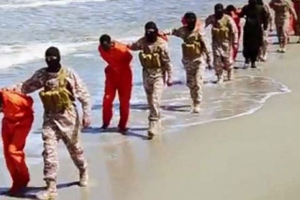Islamic State (ISIS or ISIL) jihadists continued their push in eastern Iraq and captured the small town of Husayba, 11 miles (17 kilometers) east of Ramadi and at least 14 miles (22 kilometers) west of Habbaniya, on Friday. Reports said the terror group used the same tactic in seizing the key city of Ramadi Sunday, with plenty of car bombs and heavy machine gun fire.
CNN interviewed several witnesses in the fighting and described how ISIS terrorists killed people, including innocent civilians, they suspected of supporting the legitimate government in Baghdad in the war.
One witness told CNN, "They were killing anyone who they accused of being with the police or the army."
Initial assessment from the ground appears that the ISIS militants will push further east towards Khalidiya, the last town between Ramadi and Habbaniya. Thousands of Iraqi security forces and Shiite militias have been using Habbaniya's military base and airbase as their staging point in their maneuver to retake Ramadi and other towns in Anbar province from ISIS control.
According to the report, thousands of Iraqi civilians trying to flee the fighting have been prevented from evacuating as the government shutdown the Bzebiz Bridge in Anbar province. The bridge is the only safe passage for civilians who want to flee to Baghdad where they think they will be more protected.
In recent days, the thousands of civilians have crossed the Bzebiz Bridge but it was closed Friday for still unknown reason. A woman fleeing the ISIS bloodbath who identified herself as Sabah Hamid, was quoted as saying, "ISIS from that side and from here the road is blocked. Where are we supposed to go?"
The trapped residents fear that ISIS militants would exact vengeance against them if they do not flee.
ISIS claims nuke weapon within a year
As ISIS jihadists continue their rampage in Iraq and Syria, the militants issued a statement in its propaganda magazine Dabiq, claiming it can acquire nuclear weapon within a year, said IJReview.
The report quoted an op-ed written by Western journalist as saying, "Let me throw a hypothetical operation onto the table. The Islamic State has billions of dollars in the bank, so they call on their wilayah (Province) in Pakistan to purchase a nuclear device through weapons dealers with links to corrupt officials in the region. The weapon is then transported overland until it makes it to Libya, where the mujahidin move it south to Nigeria.
"Drug shipments from Columbia bound for Europe pass through West Africa, so moving other types of contraband from East to West is just as possible. The nuke and accompanying mujahidin arrive on the shorelines of South America and are transported through the porous borders of Central America before arriving in Mexico and up to the border with the United States.
"From there it's a quick hop through a smuggling tunnel and hey presto, they're mingling with another 12 million 'illegal' aliens in America with a nuclear bomb in the trunk."
The claim has some chilling truth in its as ISIS controls some territory in Libya and has an alliance with Nigerian terror group Boko Haram.
Islamic State Claims Responsibility for Saudi Arabia Shiite Mosque Attack
On Friday, the Islamic State claimed responsibility for the bombing attack at a Shiite mosque in Saudi Arabia that killed 21 people were killed and 123 wounded, while people are worshipping. The Washington Post said this was the first time that the ISIS terrorist group has claimed an attack on the kingdom, raising fears the jihadists are ready to expand the conflict.
In a communique issued after the blast, ISIS asserted that a "martyrdom-seeking brother" set off an explosive belt while "impure" people gather to worship.
The Sunni extremists consider Shiite Muslims heretics. The Islamic State is also against the Sunni Saudi Arabia's close ties with the West.
Fears Over Palmyra's Ancient Ruins
The capture of the Iraqi towns of Husayba, 11 miles (17 kilometers) east of Ramadi follows ISIS' takeover of Syrian town of al-Tanf and the ancient city of Palmyra. The United Nations Educational Scientific and Cultural Organization (UNESCO) warned that the ancient ruins at Palmyra since the Islamic State took full control of the city after Syrian forces loyal to President Bashar al-Assad retreated from the ISIS's rapid offensive.
The UN has expressed concern that the ruins in Palmyra would suffer the same fate as the Assyrian city of Nimrud and the statues in Iraq's Mosul Museum which the Sunni Muslim jihadists destroyed when they captured the cities, reported CNN.
The Palmyra ruins are included in the UNESCO World Heritage Site list and were described as having "stood at the crossroads of several civilizations," with its art and architecture a fusion of Greek, Roman and Persian influences.
All across the globe, historians and activists have issued condemnation over the fall of Palmyra over ISIS. An activist using #SavePalmyra, tweeted, "Am screaming #SavePalmyra out of sheer despair. as I dont know who this scream is directed to or what anyone can do."
Many historians consider Palmyra as playing an important role in the world's history, and described it as a "caravan of oasis" even before the Romans gained control of the city in the mid-first century. Palmyra was a vital trade route that linked the Roman Empire to Persia, India and China during that era, the report said.
Tom Holland a novelist and historian from Britain, wrote about Palmyra and describing the city as "an extraordinary fusion of classical and Iranian influences intermixed with various Arab influence as well." He added that the destruction of Palmyra would be a great tragedy for the world and not just for the Syrian people.
Holland went on to say, "Mesopotamia, Iraq, Syria, this is the wellspring of global civilization. It really couldn't be higher stakes in terms of conservation."

















